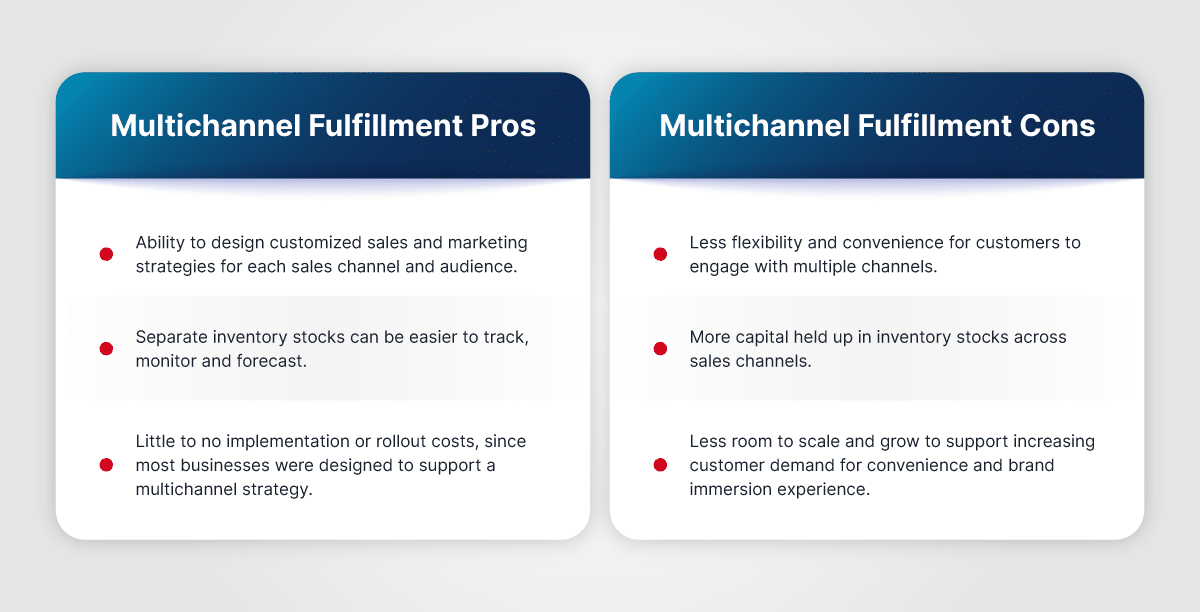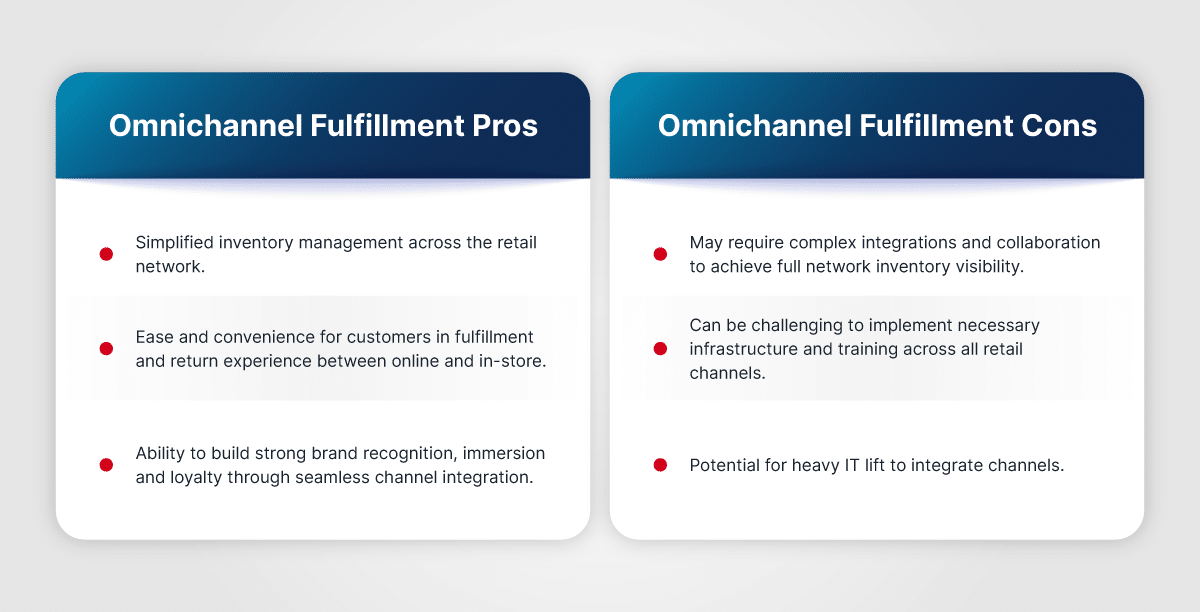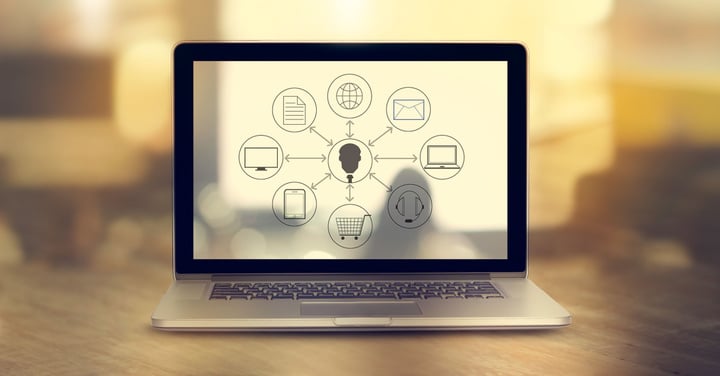The boom of e-commerce has reshaped the consumer shopping experience and forced sellers to re-evaluate their strategies for reaching customers, selling products and delivering orders. No longer can companies rely on a single channel for sales or fulfillment — to grow their brands, they must embrace e-commerce, online stores and physical brick-and-mortar locations.
Multichannel and omnichannel fulfillment strategies are critical for today’s retailers, yet the question remains, which is the better option? The fact is, either model can work if executed properly, so ultimately it depends on individual business goals and how attainable, scalable and effective a fulfillment strategy is.
This article will explore omnichannel versus multichannel fulfillment, the benefits and drawbacks of each, and how technology solutions can drive efficiency and execution for multichannel and omnichannel fulfillment.
What Is Multichannel Fulfillment?
Multichannel fulfillment is the practice of marketing and selling through various channels, like in-store, online or e-commerce platforms, where inventory in each channel is managed and processed independently. Sales and fulfillment channels are entirely siloed, and there is no visibility or sharing of inventory across the network.
In a multichannel fulfillment model, a retailer may use Amazon FBA to fulfill orders made on Amazon, while orders received on their own e-commerce website are handled by a third-party warehousing and logistics provider. Multichannel fulfillment keeps activities and order fulfillment distinct for each channel, without intermingling between operations.
What Is Omnichannel Fulfillment?
Omnichannel shares a multichannel approach to marketing and selling, utilizing multiple avenues to drive sales and revenue. What makes omnichannel fulfillment different, however, is that it integrates all inventory across the network to be visible and shared across all sales channels.
An omnichannel system can identify inventory availability at every level — from distribution centers to in-store — and select the best fulfillment options to ensure fast and efficient delivery. Omnichannel also supports buy online, pick up in-store (BOPIS) and buy in-store for home-delivery options, giving customers more flexibility and control over the shopping and delivery experience, and effectively streamlining fulfillment processes.
Additionally, an omnichannel model turns physical store locations into much more than a sales avenue. Suddenly, stores play multiple roles in the fulfillment process, including a source of inventory for online orders, a click-and-collect location and a place to return items purchased either in-store or online. This provides additional convenience for customers and improves the overall productivity and value of brick-and-mortar stores.
The Difference Between Multichannel and Omnichannel Fulfillment
Multichannel fulfillment and omnichannel fulfillment are sometimes (wrongly) used interchangeably, but there are distinct differences between the two models. This can best be examined by looking at scenarios for each approach.
- Scenario A: The customer is scrolling social media and sees an advertisement for a jacket they like. They follow the link and are taken to the retailer’s online store where they can purchase the jacket for home delivery. When it arrives, they realize it doesn’t fit correctly, so they make a trip to the nearest physical retailer location to exchange it for the right size. When they arrive at the store, the sales associate informs them they cannot accept returns or exchanges for online orders and that the return must be initiated online, and the jacket must be shipped back to the warehouse for an exchange.
- Scenario B: The customer is scrolling social media and sees an advertisement for a jacket they like. They follow the link and are taken to the retailer’s online store where they are able to see the jacket’s availability at nearby physical stores, allowing the customer to either go to the store and try on the jacket or order online for either in-store pickup or home delivery. They decide to order online for home delivery, but when it arrives and the jacket does not fit, they go to the nearest physical store and exchange it for the correct size instantly.
In scenario A, which represents the multichannel fulfillment model, the customer’s journey is fully dictated by the original channel of purchase. The retailer’s online store was able to provide the convenience of shopping from home and delivering directly to the customer, but it could not support returns or exchanges in any other channel, since inventory is maintained by each channel individually. This seemingly puts the product at the center of the fulfillment experience, much to the customer’s chagrin.
In scenario B, which represents an omnichannel approach, the customer has access to inventory across the network and can choose the fulfillment options, and subsequently the exchange and return options, that best suit their needs. Since all sales channels share inventory, there is more flexibility for fulfillment and returns. This model focuses less on where the product “belongs” and more on the customer’s retail experience.
These scenarios highlight how multichannel and omnichannel models impact two important components of fulfillment: customer experience and fulfillment efficiency. Customer experience can be defined as the ease of the purchase and return process from the customer’s point of view. Fulfillment efficiency speaks to internal processes and how well they are optimized to minimize overall costs and labor efforts in the fulfillment chain.
Multichannel vs. Omnichannel: Which Is Better for Your Business?
When it comes to fulfillment, today’s retailers understand the importance of meeting consumer demand for speed, efficiency and convenience. Unfortunately, determining the best fulfillment model can be complicated and requires a comprehensive evaluation of current fulfillment networks, specific customer expectations and overall business and revenue goals.
There are benefits and drawbacks to both multichannel and omnichannel fulfillment approaches, so retailers should consider every facet and choose the option that best aligns with their business strategies and goals.
Multichannel Fulfillment: Pros and Cons
Multichannel fulfillment models allow for the creation of unique messaging and experiences in each channel, but may be less efficient and convenient due to inventory and communication siloes.

Omnichannel Fulfillment: Pros and Cons
Omnichannel fulfillment models offer many of the same sales benefits as multichannel since they allow for marketing and sales across numerous channels. The true differentiation lies in fulfillment flexibility and inventory management, although omnichannel implementation and rollout may be complex.

Technology Solutions for Multi- or Omnichannel Fulfillment
Regardless of whether an organization chooses a multichannel or omnichannel fulfillment approach, implementation and execution require a well-considered strategy for connecting previously disparate channels and business processes. Fulfillment technology solutions are designed to remove friction in multichannel and omnichannel fulfillment, by bridging communication gaps and integrating complex technology networks under a single platform.
Fulfillment orchestration technologies should streamline multi- and omnichannel fulfillment by supporting multiple functions throughout the fulfillment process. Look for technology that features solutions in these critical areas:
- Fulfillment Control Tower – Fulfillment technology should integrate data from existing systems, like WMS, TMS and ERP, to provide reliable visibility across fulfillment and delivery processes. This helps ensure that orders are captured, packed and shipped in the most efficient manner.
- Last Mile Optimization – Multichannel fulfillment and omnichannel fulfillment rely heavily on the ability to meet customer delivery expectations. Fulfillment technology that automates courier selection and delivery order functions creates a more cost-effective, optimized transportation network and cuts back on manual logistics processes.
- Exceptions Management – Fulfillment technology should integrate real-time tracking updates from across the delivery courier network to quickly identify shipments at risk of missing delivery targets. This enables speedy escalation and exceptions management to ensure that issues are addressed before they turn into missed deliveries.
- Customer Experience – Multi- and omnichannel models are designed to create a continuous brand experience that flows from marketing and sales through final delivery. Fulfillment technology should support the customer experience by keeping a retailer in direct contact throughout the last mile journey, with customized branding and messaging every step of the way.
- Actionable Data – Fulfillment technology that provides reliable data to drive revenue, increase efficiencies and inform decision-making is critical to any omni- or multichannel strategy. These solutions should give retailers access to meaningful data on every order and delivery, helping to predict outcomes and forecast future delivery needs and network coverage.
Optimize Your Fulfillment Operations by Teaming Up with OneRail
Now more than ever, retailers need a reliable partner to help them implement a technology-driven multichannel or omnichannel approach that streamlines fulfillment and last mile processes. OneRail’sfulfillment solution delivers an enterprise-capable API for integration and a vast last mile delivery network that is proven to be 99% on-time and reliable.
With OneRail, brands can exceed expectations in the omnichannel retail market, building long-lasting customer loyalty and repeat sales. Schedule a demo today to see how OneRail can simplify and optimize your fulfillment operations.


